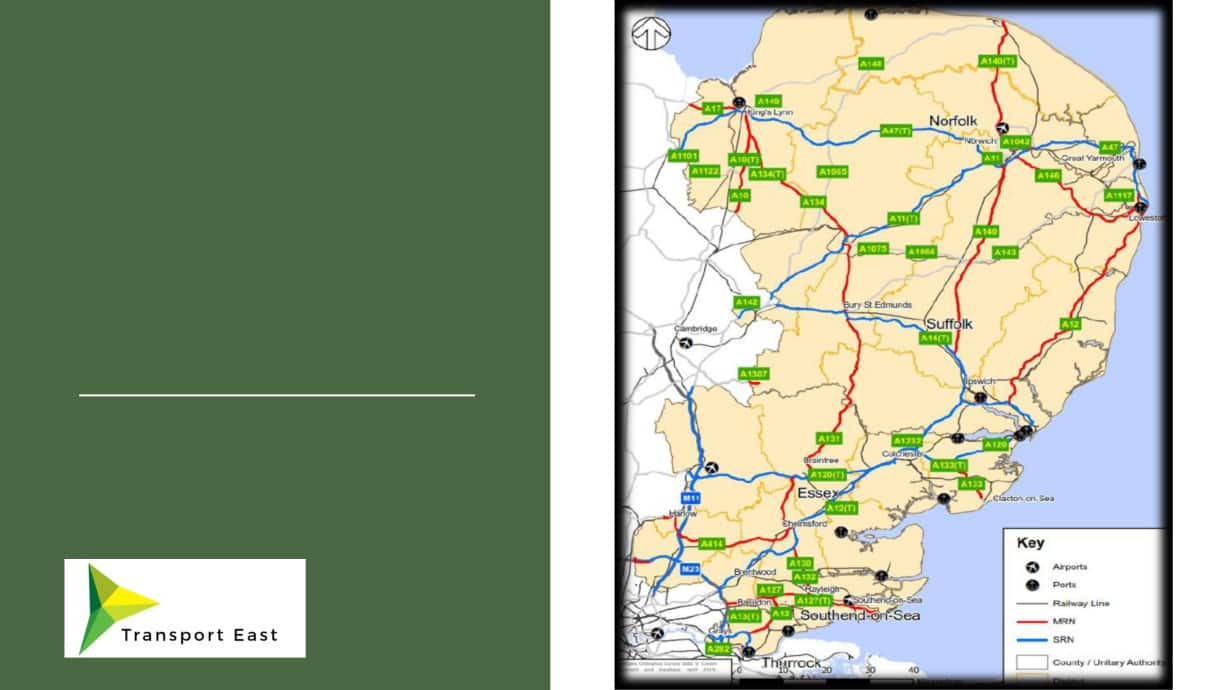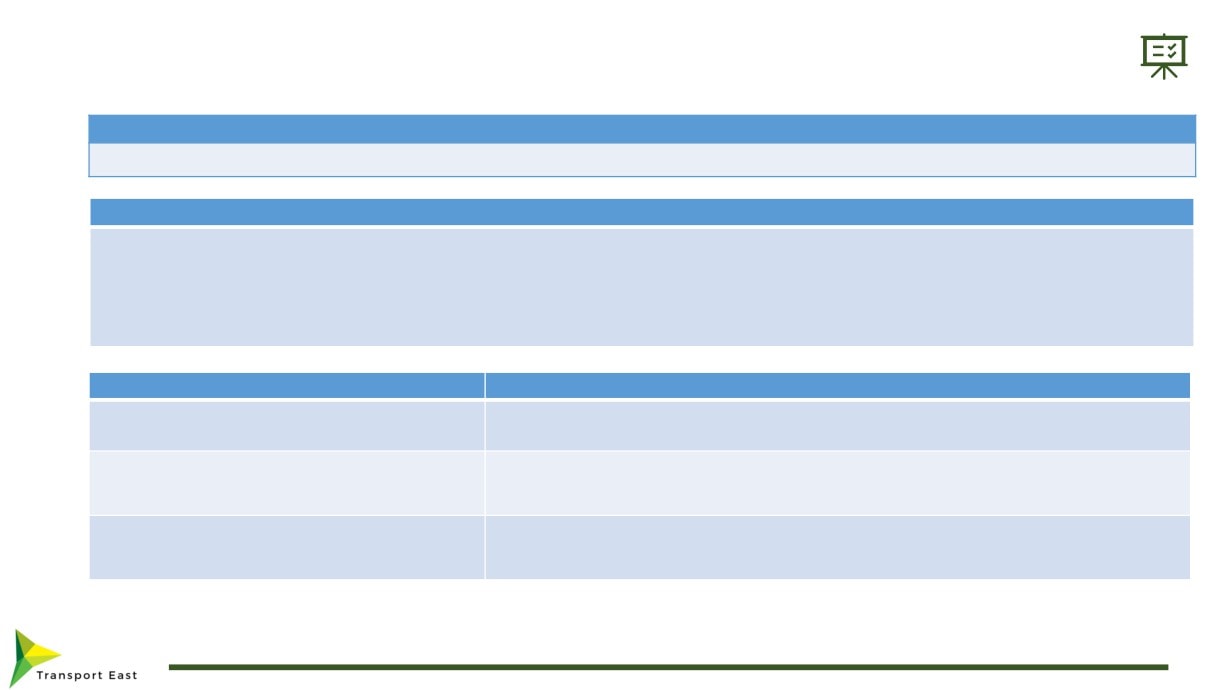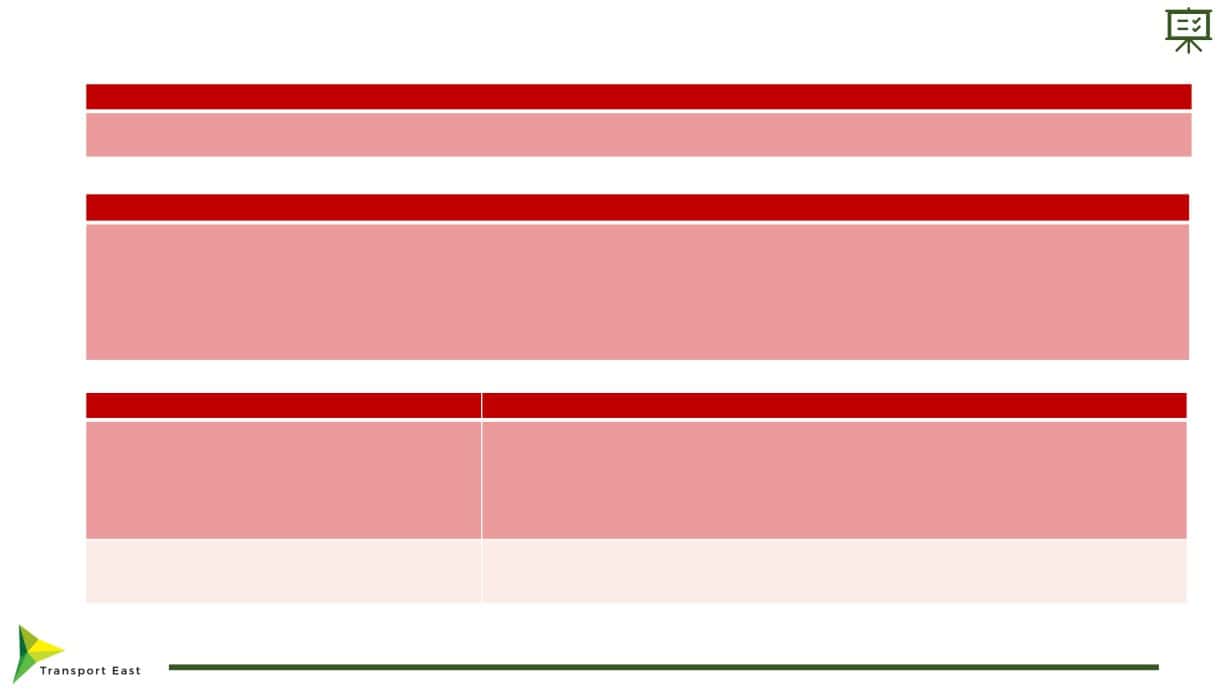New Anglia Transport Board
Assessing impact and Recovery Plan
Agenda
9.30-11.00am, Tuesday 2nd June 2020 - Virtual Teams meeting
9.30
1.
Welcome and introductions
Chair
9.30
2.
Minutes and matters arising
Chair
9.35
3.
Impact of Coronavirus
All
• Updates and feedback
• Challenges and Opportunities
10.15
4.
Transport East update
Andrew
• Introduction
Summers
•
100-day plan
•
Feedback and comments
10.40
5.
New Anglia LEP Recovery Plan
Laura
• Purpose of plan
Waters
• Actions
10.50
6.
New Anglia LEP Sub Board Reporting
Chair
10.55
7.
Any other business
All
• Forward Plan and items for next meeting
• Date of next meeting - 9.30, August 25th, virtual meeting or
Endeavor House
Officer Contact
If you have any questions about matters contained on this agenda, please get in touch with:
Laura Waters
07384 258662
New Anglia Transport Board
Agile to Change
Meeting Note
1.00pm - 3.00pm, Tuesday 25th February 2020 - Ipswich Town Hall, Ipswich
In attendance:
Paul Ager
ABP
Simon Amor
Highways England
Matt Capp - for item 3
BT
Karen Chapman
Suffolk Growth Programme Board
Andrew Chillingsworth
GT Railway
David Cumming
Norfolk County Council
Paul Davey
Hutchison Ports
Jonathan Denby
Greater Anglia
Doug Field - chair
New Anglia LEP
Ellen Goodwin
New Anglia LEP
Riz Hanid - for item 6
Network Rail
Graeme Mateer
Suffolk County Council
Desi Reed - observer
East Suffolk Council
Richard Pace
Norwich Airport
Richard Perkins
Suffolk Chamber of Commerce
Jonathan Rudd
New Anglia LEP
Cllr Phil Smart
Suffolk District Councils
Chris Soule
CLA
Andy Walker
Suffolk Chamber of Commerce
Laura Waters
Norfolk County Council
Cllr Martin Wilby
Norfolk County Council
Apologies
James Bradley
Network Rail
Philip Broadbent-Yale
Sustrans
Jamie Burles
Greater Anglia
Ali Clabburn
Liftshare
Cllr Stuart Clancy
Norfolk County Council
John Dugmore
Suffolk Chamber of Commerce
Nova Fairbank
Norfolk Chambers of Commerce
Andrew Harston
ABP
Paul Horne
Suffolk County Council
Patrick Ladbury
GT Railway
Paul Martin
First Buses
Andrew Mower
FSB
Cllr Graham Plant
Norfolk District Councils
Cllr Andrew Reid
Suffolk County Council
Sue Roper
Suffolk County Council
Steve Wickers
First Buses
Minutes and matters arising
Richard Pace and Cllr Phil Smart apologies to be noted for the last meeting.
ACTION - last note to be amended and re-issued
All other matters arising covered by the agenda or circulated to the Board.
Innovation in Transport
Matt Capp attended and updated the Board on innovation with respect to transport at Adastral Park, who
have implemented various elements of technology to detect & share details of traffic and transport
problems to ensure minimal disruption to daily ingress and egress. They have also encouraged more take
up of sustainable travel. These are measures that might benefit commuters elsewhere.
Transport and clean growth
Ellen Goodwin introduced the paper and outlined the previously circulated information regarding the Norfolk
and Suffolk Investment Plan.
The Investment Plan is a new proactive way of working designed to help influence and negotiate as well as
lever in private sector investment. The LEP has a current call for EOIs out which will close on 20 March,
but it is very much an iterative process. The Board were asked what they would like to achieve and what
interventions may help to deliver these ambitions. Projects submitted via the EOI process must meet LEP
strategic objectives and demonstrate value for money to be considered for inclusion.
Comments received prior to the meeting:
Opportunities for walking and cycling need to be included. With the increasing number of electric
bikes, the reasonable commute by bike has increased from 5-7 miles to 10-12 miles.
The importance of sharing was highlighted as a key avenue to pursue alongside other actions in the
shorter term.
Active Design can support behavioural change.
ACTION - Sports England offer to present at June meeting with respect to Active Design
Comments at the meeting:
Public transport and EV network key to pursue
Importance of freight and associated barriers i.e. Ely must be considered. Electrification of rail.
Regularity of passenger transport options will help drive behaviour change
Green credentials are positive but sometimes have tax disincentives - do we need to challenge?
NCC environmental policies - carbon neutrality by 2030. UEA and others to look at carbon
emissions across the county in more granular detail to develop policy instruments and their impact.
Transport East decarbonisation agenda to be considered
Rail network set up for times gone by - how do we modernize affordably?
Airport Masterplan access strategy, its associated carbon reduction ambitions and link to TCF
Need to think about quick wins re. rail and influence Government/fund locally. Consider a common
message and promote accordingly
DfT silos makes clean growth challenging as options often demand an integrated approach
ACTION - relevant actions to be considered as part of the clean growth action plan
ACTION - come back to specific interventions next time
Transport East update
The rescheduled Transport East Summit is 26 February 2020. The agenda will cover work and
achievements to date and opportunities with respect to the upcoming Transport Strategy around strategic
connections, working with other areas, inclusive growth and the decarbonisation agenda.
The new Transport East Director has been appointed and is due to start on 14 April.
Transport East is taking a new approach regarding it’s decarbonisation agenda as the inquiry approach
was proving challenging. A consultant will be appointed to do some detailed work moving forward which will
include an event of some description.
The Body has asked DfT for funding this year and next and has done this through a range of scenarios.
The Department has been clear that funding will not fund staff, although this may be different to the
approach taken for Transport for the North.
Ely update
Last presented in November 2018. The programme is now much broader due to complicated geography
and need for risk mitigation. Development work has concluded that improvements are unlikely to get us all
the additional train paths we want without additional work on other parts of the network. A scaleable
solution is attractive to DfT but we need to be mindful that solutions are needed outside the Programme in
order to reap the widest possible benefits in the longer term.
BCR currently at 1.5 (central case) or 2.3 (for an initial freight focused approach)
New Anglia LEP has co-funded the Strategic Outline Business Case due to be submitted to HMT and DfT
at the end of March. An announcement regarding next steps is expected by May 2020. £10-15m is
needed for the Outline Business Case development stage which would take around 18-24 months to
complete. Network Rail are working to understand what elements of the scheme could start to be delivered
between 2023 and 2025 depending on various funding decisions.
Need to work nationally to develop (political) momentum.
ACTION - influencing strategy between now and May to be considered
Making the Integrated Transport Strategy Happen
Roads Investment Strategy
RIS 1 - A47 schemes moving forward: consultation on North Tuddenham to Easton starting 26 February
2020. Other Development Consent Orders advancing this year. A14 opened early.
RIS 2 - delivery to start in April.
Orwell Bridge closures work advancing, looking at flap and variable messaging options regarding reduced
speed limits in high winds.
Transforming Cities Fund
Greater Norwich already delivering phase 1 including Beryl Bikes scheme over the next few months.
End of March decision on phase 2 funding expected.
Haughley
Haughley decision to design expected in June 2020. Need to appropriately align with Ely. £1m from
Suffolk public sector leaders but costs have increased. Important to coordinate road/rail improvements.
ACTION - take forward coordinated delivery approach with Ellie Burrows
Trowse
Partners have agreed to look at how we take forward improvements at Trowse.
GEML
The Taskforce met on 10 February which was the first meeting chaired by the new Chair Giles Watling MP.
Rollout of the new Stadler trains continues across the rural routes and two of the new intercity trains have
recently been introduced on the Norwich to London line. Rollout of further intercity trains will continue over
the coming months.
All Intercity trains should be introduced by next meeting in early June 2020 - need to improve infrastructure
to reap all benefits.
ACTION - Norfolk and Suffolk Unlimited case study to be delivered thereafter
The project board is considering the revised draft business case for the evidence refresh on 27 February.
Others
NCC - Local Transport Plan review consultation closes 28 February.
Freeports consultation
Open until 20 April
Terms of Reference
Regular attendance was suggested as an appropriate criterion for consideration.
ACTION - Chair to consider options
AOB including Forward Plan
New Anglia Transport Board
Tuesday 2nd June 2020
Agenda Item 3
Impact of Covid-19 on transport
Author: Laura Waters
Summary
This paper provides a summary of the impacts Covid-19 has had on various modes of
transport, which will help in understanding the most critical areas and begin to develop a
plan for the short, medium and longer terms interventions required for a strong recovery.
Recommendation
The Transport Board is asked to:
• Feedback on the challenges and opportunities the situation presents
• Identify measures/actions needed in both the shorter and longer terms to address the
most critical areas
Background
At the start of 2020, Norfolk and Suffolk businesses, education providers, local authorities,
the voluntary and community sector and the LEP had a clear vision, ambitions and plan to
drive economic growth across Norfolk and Suffolk, which is set out in Norfolk and Suffolk
Economic Strategy and Local Industrial Strategy.
This remains our ambition despite the impact of Covid-19. It will be a greater challenge and
we will need to identify opportunities through transport infrastructure, which could make
significant advances in some areas of the economy. We will need to adjust to new way of
working to support our economy to be agile and responsive to these challenges and
opportunities.
Impacts on the transport network since the lockdown measures include a significant
reduction in traffic flows on our strategic road network with a decrease to 19% compared to
same period in 2019, all fixed wing passenger flights except for one service stopped at
Norwich Airport and First Buses are carrying around 10-15% of normal passenger numbers.
Moving forward we will need to consider how best to recover from these impacts, identifying
which measures and actions are required to address the most critical areas and ensuring
transport infrastructure grows stronger. We will also need to consider the implications of the
guidance Government published on the 12 May 2020 setting out how operators can provide
safer workplaces and services for themselves, their workers and passengers across all
modes of private and public transport.
Summary of feedback received:
The feedback on the impact of Covid-19 on transport infrastructure appears to be focussed
on four key themes:
1. Understanding the level of service required and the ability to increase passenger
numbers to sustain business, whilst maintaining social distancing measures
2. Clear direction from government on their commitment to existing projects and what
funding will look like in the future?
3. How to capture benefits such as the improvements in air quality and increased
walking and cycling the restrictions have created?
4. Building public confidence around using public transport
Detailed comments included:
•
Delivery of schemes has been temporarily paused - investigating impact of this
pause where the funding comes from DfT because the money awarded may not have
been spent in the original timeframe for the grant.
•
Business case work on major projects is able to progress.
•
Being extremely careful of tasks such as surveying, which require accessing land to
ensure social distancing is maintained.
•
Fees for design work etc could be higher due to staff availability.
•
Potential issue in respect of major projects and the timing of future
announcements/decisions - it would be useful to have some assurances / indications
from government about their intentions. That is, will they continue to be able to
honour existing programme commitments or is Covid-19 likely to lead to reductions in
infrastructure funding programmes?
•
People are driving less, but how do we ensure car use does not increase rapidly
once lockdown is eased (which has been seen in Wuhan).
•
Walking and cycling levels have increased significantly - how do we harness these
increases?
•
The three Ports in East Anglia have all been fully operational with volumes in the
main buoyant, but clearly with some peaks and troughs.
•
All fixed wing passenger flights except for a daily Aberdeen service (Mon to Fri)
stopped by 27th March.
•
Offshore gas helicopter traffic is continuing at about 50% of predicted pre Covid 19
levels due to the required social distancing measures required.
•
Changes to bus timetables to reflect the reduction in travellers and First Bus are
carrying around 10-15% the normal number of passengers.
•
Results from the Liftshare commuter survey found almost half (48%) of its members
will be changing the way they travel to work after the lockdown lifts. Opportunities to
help organisations safely return people to work using technology to assess commuter
routes and advise employees on the best routes to work in relation to social
distancing.
•
The Liftshare commuter survey found their members have significantly increased
working from home (552%), increased cycling (71%) and increased walking (8%).
Identifying measures and actions to address critical areas
There will be different phases of recovery as the lock down is lifted gradually and impact
different parts of the economy at different times meaning we will need to consider short and
long term interventions some of which may need to be specific to a particular mode of
transport but also explore opportunities for interventions that work across multiple transport
areas.
It is important that our approach considers the transition between response, restart and
rebuild and be agile to the possibility that we may need to transition back into response if
there are further lock downs.
As part of this discussion we can:
• Use the Economic Strategy and Local Industrial Strategy to identify relevant activities
that can assist in recovery planning
• Assess local and central government funding opportunities and gaps
• Consider new interventions that will support opportunities around for example skills
and training
• Use the safer transport - guidance for operators published by government, and
consider the implications of suggestions such as: Re-deploying vulnerable
employees, use of screens and barriers, eliminating face to face seating, staggering
departure times and undertaking joint planning with other transport organisations.
Recommendation
The Transport Board is asked to:
• Feedback on the challenges and opportunities the situation presents
• Identify measures/actions needed in both the shorter and longer terms to address the
most critical areas
New Anglia Transport Board
Tuesday 2nd June 2020
Agenda Item 4
Transport East 100-Day Plan
Author: Andrew Summers, Strategic Director, Transport East
Summary
The Transport East partnership is our Sub-national Transport Body (STB), created in 2018
by leaders across Norfolk, Suffolk, Essex, Southend and Thurrock to provide a single voice
on our region’s transport strategy and strategic transport investment priorities.
To accelerate its work programme, Transport East appointed a Strategic Director in April
2020. This 100-day plan proposes the short-term actions now required to ensure Transport
East is fully capable of influencing and securing national transport investment to support our
economic, social and environmental goals and ambitions.
The New Anglia LEP is a key member of Transport East, and actively participates on the
Transport East Senior Officer Group and the Transport East Forum. This 100-day plan has
been scoped out via a workshop with LEP officers and other core Transport East partners,
and the New Anglia Transport Board is invited to provide further input and steer today.
Purpose of this paper
The Transport Board is asked to:
• Review the four proposed work packages set out in the 100-day plan (see appendix)
and propose any further activities
• Discuss opportunities for collaboration and further joint working between the LEP
Transport Board and Transport East
Background
The Transport East partnership is one of seven STBs established across England following
the government’s 2016 legislation to deliver greater devolution to sub-national areas. The
purpose of STBs is to act as a single voice for their regions on transport matters, with
specific roles to:
• Develop and communicate a single transport strategy and strategic investment
programme, with its priorities ultimately embedded in the delivery plans of
government, Network Rail, Highways Agency, private sector and other transport
providers.
• Provide a strong, loud and collective regional voice in the national planning,
prioritisation and delivery of strategic transport improvements, helping to ensure
investment decisions are locally supported, evidence-led, joined-up and take a
strategic long-term approach
• Enhance the work of existing local transport bodies and Local Enterprise
Partnerships by ensuring that funding and strategy decisions about the sub-national
transport system are informed by local knowledge, outcomes and requirements
• Provide leadership and strategic oversight on strategic transport priorities which
cross local authority or regional boundaries.
The members of the Transport East partnership include Norfolk, Suffolk, Essex, Southend
and Thurrock transport authorities, LEPs (both New Anglia and SELEP), district councils,
Highways England, Network Rail, the UK Innovation Corridor, Chambers of Commerce and
other partners. Transport East works closely with its wider partners across the region
(including ports, airports and other infrastructure and transport operators), as well as the
Department for Transport and the wider English STB network, particularly the neighbouring
STBs (Transport for the South East, England’s Economic Heartland and Midlands Connect).
To date the work of Transport East has been undertaken by its members, however Transport
East appointed a Strategic Director in April 2020 as its first dedicated resource.
Next Steps for Transport East: A 100-day plan
The Strategic Director and Senior Officers Group (including LEP officers) have reviewed the
member, wider partner and government requirements of Transport East, and subsequently
developed a 100-day plan to progress Transport East to its next stage of maturity. The plan
establishes four work packages to progress our four priority outcomes:
A) Transport East as a functional and representative STB - A successful,
effective and well-run STB, fully championing the aspirations of the Transport
East partners, working in close partnership with DfT and the rest of the UK.
B) Transport East evidence base and strategy - An ambitious, focused and
coherent Transport Strategy, based on evidence, fully reflecting the unique ambitions
of local partners and aligned to national goals (including COVID19 recovery).
C) Investment and delivery planning - A pipeline and delivery plan for investment
priorities, aligned to the Transport Strategy, supporting local authorities and
infrastructure providers to develop, fund, accelerate and deliver priority projects.
D) Partnerships, communications and advocacy- Transport East speaks as a
single voice for its constituent partners, with our priorities communicated loudly,
credibly and effectively via a close working relationship with the government and
other STBs.
The full 100-day plan is set out in the appendix.
Recommendation
The Transport Board is asked to:
• Review the four proposed work packages set out in the 100-day plan (see appendix)
and propose any further activities
• Discuss opportunities for collaboration between the LEP Transport Board and
Transport East
APPENDIX:
Next Steps for Transport East:
Proposal for a 100-day plan
May 2020
Andrew Summers
Strategic Director
Transport East
1
Purpose of this note:
• To summarise the progress made by the Transport East partnership to date, and set the context for the next
phase of work
• To scope the aims and objectives for the Strategic Director's 'first 100 days' from mid-April 2020
• To capture the range of activities already underway by Transport East's lead officers, and propose how
the TE Strategic Director can work with officers to progress these to the next stage as distinct work packages
Contents:
1.
Background and Context (p.3-4)
2.
100-day plan - Aims and objectives (p.5)
3.
Progress to date and four work packages (p.6-10)
This plan has been produced following early
4.
Ways of working (p.11)
discussion between the Strategic Director and other
5.
Next Steps (p.12)
TE officers and subject to further refinement with
partners over the 100-day period to 22 July 2020.
2
Background and Context (Transport East and SNTBs):
• The Transport East partnership was initiated in 2018, and a comprehensive work
programme subsequently driven forward by Senior Officer’s Group, guided by the Forum
and local authority leaders, with significant achievements already completed.
• Transport East is subsequently very well placed to evolve to the next phase of
its development.
• A Strategic Director was appointed in April 2020, providing a first dedicated staff
resource to support the partnership to develop Transport East into the future.
• The next year is crucial for Transport East and other emerging STBs across
England. They have an opportunity to become a vital part of England's transport
governance, providing a single powerful voice for their constituent partners,
establishing transport strategies across functional partnership geographies that address
both local and national objectives, and providing a clear route to DfT for identifying and
delivering strategic transport priorities.
• Transport East is at an earlier stage of development compared to other STBs, and our focus is on the priority tasks required by
the partnership and DfT to be accelerated most rapidly.
• In the context of the above, this 100-day plan scopes out potential priorities and a work programme for the new Strategic
Director and the Senior Officer Group to undertake with regional leaders and other partners.
3
Background and Context (live issues):
• Transport East's next steps will take place in the context of significant events and changes at local and national level:
❑ At a local level:
▪ The region has been in COVID-19 lock-down, which has significantly impacted short-term travel behaviours.
Immediate transport priorities have included supporting key workers to move safely, maintaining the supply chain,
and supporting the vulnerable in society.
▪ The lock-down has serious operational and financial consequences for many local transport providers, including
aviation, taxi/private hire and passenger transport sectors, and Transport East's future strategy will need to consider
how these sectors recover, alongside longer-term objectives.
▪ Post lock-down, new transport patterns may emerge in the region - some as a permanent shift. Many restrictions
may be in place until next year, impacting on local travel choices, with potentially more home-working and
challenges for passenger transport operators.
❑ A national level:
▪ The national political, economic and social landscape may look significantly different post-COVID-19. Transport East
will need to be ready to adapt to new government funding priorities and a significantly different economic
situation, with efforts focused on recovery.
▪ The national focus on post-Brexit arrangements will influence our strategy (e.g. new tariffs). The role of the East as
an international gateway region will grow in importance, and we'll need to be equipped to capitalise on this.
▪ Away from COVID-19 and Brexit, there is increasing DfT emphasis on de-carbonising the transport network. This,
and other emerging national priorities (including the future of the national ‘levelling-up’ policy approach), will
significantly shape the direction of Transport East's future strategy.
4
100-day Plan: Aims and objectives
The aim for the first 100 days is to: ‘work in collaboration with the wider Transport East partnership
team to drive forward Transport East's next phase of development, strategy and partnership-building’.
The Strategic Director has three core objectives for the first 100 days:
Agree the next steps and
Support and strengthen
Establish and strengthen
resourcing for the
the Transport East 'ways of
relationships with partners
work programme and make
working', building on the
across the Transport
significant progress in each
excellent working partnerships
East region, and beyond,
of the four work packages,
and collaboration already
including neighbouring regions,
focusing on priorities
established, and promote
other STBs and government
shared learning
partners
(See slides 6 - 10)
(See slide 11)
5
Transport East Work Programme - progress to date, next steps and long-term outcomes:
Work package
Progress to date
Next 18 months (core outputs in bold)
Outcomes (long term goals)
✓ Representative political Forum established
A successful, effective and well-
✓ Officer Steering Group established
❑ Develop TE governance to ensure alignment with emerging
run Sub-ational Transport Body,
1. Transport East as
✓ Terms of Reference endorsed
requirements of the national STB / DfT agreement
fully championing the
a functional and
✓ Accountable body and secretariat in place
❑ Ensure capability, resources, governance and political
aspirations of the Transport
representative STB
✓ TE partner funding commitments agreed
accountability are in place to deliver the work programme
East partners, working in
(slide 7)
✓
1 x dedicated staff recruited (Strategic Director)
close partnership with DfT and
❑ Scope and develop a Transport East Business Plan
✓
20/21 funding bid submitted to DfT
the rest of the UK
✓ Three core strategic priorities agreed
An ambitious, focused and
❑ Complete carbon inquiry and KPMG evidence base
✓ Regional evidence base (highways) published
coherent Transport Strategy,
2. Transport East
❑ Complete wider evidence base across all modes and strategic
✓ Carbon evidence base initiated
based on robust evidence, fully
evidence base and
outcomes, and compile into a consistent format
✓ Extensive local expertise, strategies and evidence
reflecting the unique ambitions
strategy (slide 8)
❑ Understand and capture all partner aspirations and goals
in place at district, county and corridor level,
of local partners and aligned to
✓ Economic evidence in place via LEPs & local bodies
❑ Plan, initiate and complete the Transport Strategy
national goals
A pipeline and delivery plan for investment
3. Investment and
❑ Understand existing investment programme and local /
✓ Project pipelines managed by local authorities
priorities, aligned to the Transport Strategy,
delivery planning
regional / national priorities
✓ MRN bids submitted to government (ongoing)
supporting local authorities and infrastructure
(slide 9)
✓ Engagement with consultations (e.g. LTC)
❑ Compile interim Investment and Delivery Plan
providers to develop, fund, accelerate
❑ Develop longer term Investment and Delivery Plan
and deliver priority projects
4. Partnerships,
Transport East speaks as a single voice for its
✓ Annual Transport Summit established
❑ Complete partnership mapping to understand existing
consituent partners, with our priorities
communications
✓ Website constructed
relationships, gaps and opportunities
communicated loudly, credibly and
and advocacy
✓ Core narrative and elevator pitch agreed
effectively via a close working relationship
❑ Develop Transport East Communications Plan
(slide 10)
with the government and other STBs
6
Work Package 1 - Transport East as a functional and representative STB:
Outcome:
To ensure Transport East is a successful, effective, accountable and well-run Sub-National Transport Body, fully championing the aspirations of the Transport East partners,
working in close partnership with DfT and the rest of the UK
Background:
•
Transport East already has a well-developed governance, with a Terms of Reference and key governance mechanisms in place, including a Board (the Forum), Officer
Steering Group, committed budget, secretariat, an accountable body, and first employed officer.
•
At a national level, Transport East is working with the government to review its existing arrangements and resources, and put in place additional measures to support TE
in reaching the next phase of its development.
•
To progress to the next stage of organisational maturity, Transport East could bring existing and required elements together into a single business plan, endorsed by the
Forum, which: (1) Sets a clear plan for the operation and development of Transport East as a functional body (2) Provides public transparency of TE's functions and
activities, and (3) Provides assurance and accountability to TE's funding partners and DfT.
Priorities and next steps
'100-day' tasks
Establish the remit of Transport East to maximise 'added
a) Review partners' priorities for Transport East through partnership discussions by end of first 100 days (and
value' and minimise 'duplication'
communicate specific role of TE to partners)
b) Review of existing Transport East governance (and arrangements of other STBs) and undertake a gap
analysis against future requirements (including compliance with emerging DfT / national SNTB agreement)
Review of existing and emerging governance requirements,
c) Set out aims, objectives and scope for TE's long term operations - and develop options for discussion with
to ensure fit for purpose for the future
local partners and the Forum/Board. Identify role of paying members, observers and other partners.
d) Set a timetable and work programme by end of July 2020 for developing a draft Business Plan
Resourcing and funding the work programme (work
e) Review resources available to deliver the work programme and create a resource plan by end of June 2020
packages 2, 3, and 4)
f) Initiate short-term activities to secure new resource where needed to progress work packages
7
Work Package 2 - Transport Strategy:
Outcome:
An ambitious, focused and coherent Transport Strategy, based on robust evidence, fully reflecting the unique ambitions of local partners and aligned to national goals
Background:
•
Transport East has already established three core strategic priorities: (I) Global Gateways; (ii) Multi-centred growth; and (iii) Energised coastal areas
•
Within the region, local partners have already established a range of local strategies, priorities and proposals to support economic, social and environmental goals
•
The government also has clear goals for the future - related to housing, economic growth (including 'levelling up’), the environment and increasingly de-carbonising the
transport system. The full implications of the COVID-19 lockdown and recovery will also strongly influence future local and national policy.
•
The region is also making good progress towards a comprehensive evidence base to understand how its transport system can be developed to address these challenges.
•
We now need to bring these aspirations and evidence together into a single coherent Transport Strategy, that is fully owned and endorsed by Transport East's partners
Priorities and next steps
'100-day' tasks
Complete the regional evidence base
a) Complete Carbon Inquiry report with KMPG by July 2020
b) Review existing evidence base, identify gaps, and agree a plan to fill gaps by end June 2020
Fully understand partners' aspirations and goals
c) Review Transport East partners’ strategic goals and existing strategies, and feedback already received (e͘g͘
through Transport Summit workshops) by June 2020
d) Identify gaps in understanding partners' goals and plan to address them (e.g. young people, etc)
Project manage the initiation and completion of the
e) Create a project plan, virtual team, timescales and methodology for the Transport Strategy. Hold a partner
Transport East Transport Strategy
workshop to fully scope out next steps in June 2020.
f) Initiate project plan, making rapid start on the strategy and be well progressed by end of 100 days
8
Work Package 3 - Investment and Delivery Plan:
Outcome:
A pipeline and delivery plan for investment priorities, aligned to the Transport Strategy, supporting local authorities and infrastructure providers to develop, accelerate
and deliver priority projects
Background:
•
The DfT require STBs to speak with a single voice on their partners' investment priorities, and will increasingly approach STBs for advice on local funding priorities, that
are aligned with the Transport Strategy
•
Transport East partners have also expressed their desire for support in progressing schemes from 'ideas' phase, through to feasibility and business case stages
•
Transport East therefore has a clear role in supporting its partners to develop and promote a pipeline of investment priorities, helping to secure funding through a range
of sources (not only DfT, but Network Rail, Highways England and other). An Investment & Delivery plan is required, alongside the Transport Strategy
Priorities and next steps
'100-day' tasks
a) Review existing partner documentation and speak with all scheme promoters, to create an ‘interim’
Understand and capture all of Transport East's existing
investment and delivery plan (for use over next 3-6 months). To include a full list of schemes or priorities in
investment priorities in an 'interim’ Investment & Delivery
construction, in-flight, in feasibility, or at ‘ideas’ stage͘ Complete by July 2020, and use to respond to short
Plan (I&DP)
term funding opportunities.
b) Alongside the Transport Strategy, scope the requirements of a long-term Transport East Investment &
Develop a long-term I&DP alongside the Transport Strategy,
Delivery Plan, comprising existing and new transport investment priorities, to support partners in delivering
comprising existing priorities alongside new interventions
their local priorities and wider strategic priorities in partnership with other national partners. To include the
required to achieve the strategy
role of private sector and enterprise finance, alongside public sector. Scope the requirements for this, in
partnership with the senior officer group, by end July 2020
Establish a mechanism for supporting partners to accelerate
priority projects to a stage at which they can attract funding
c) Hold an officer’s workshop on 5th June 2020 to scope the specific ‘added value’ role that Transport East
(minimising duplication with scheme promoters / local
should perform in supporting local authorities to develop investment priorities into deliverable schemes.
authorities, but maximising ‘added value’)
9
Work Package 4 - Partnerships, communications and advocacy:
Outcome:
Transport East speaks as a single voice for its consituent partners, with our priorities communicated loudly, credibly and effectively via a close working relationship with the
government and other STBs
Background:
•
The government requires STBs to speak as a single voice for the region. To enable this, Transport East needs excellent communication mechanisms, to ensure the
partners' strategic goals and investment priorities are accurately understood and agreed by the Transport Forum and regional advocates
•
Over the last few years, the national funding debate has focused heavily on a ‘levelling-up’ investment approach͘
•
At a scheme-specific level, the presence of a robust evidence base and business case is only part of the prerequisite for funding. Partnership working, alongside sustained,
loud and credible advocacy and case-making is needed to secure funding for priorities.
•
There will also be transport priorities that transcend multiple STBs, and Transport East must be equipped to play a key role in helping make the case for these
•
Transport East needs a Communications Plan
Priorities and next steps?
'100-day' tasks
a) Hold workshop with Transport East members in June 2020 to establish requirements and next steps for a TE
Review TE communications activities and identify next steps:
Communications Plan
• Stage 1 - agree communications plan goals with TE
b) Identify communications/advocacy resource gaps and identify next steps for filling these by June 2020
members
(Communications and advocacy is a particularly important, specialist and time-intensive activity ,and Transport
• Stage 2 - initiate communications plan
East needs adequate resource and expertise in this area to be successful).
c) Present proposals for Communications Plan at Transport Forum in July 2020
Undertake partner mapping exercise to establish and
strengthen Transport East relationships and understand
d) Strategic Director to complete partnership introductions in first 100 days
partners' existing priorities and opportunities
10
Ways of working:
• Members of the Officer Group, alongside local authority leaders, have successfully progressed Transport
East to its current position, and this collaboration and team-working is crucial to its ongoing success.
• A TESOG 'ways of working' workshop was held on 4th May to build on what already works well, and
scope out how the expanding partnership team should best work together going forwards.
• Based on the three core elements of 'working together' the workshop agreed:
✓ Individual roles and responsibilities
1. Collaboration
✓ Collaboration culture and mechanisms
✓ Meeting arrangements (Senior Officers, Forum, other partners)
2. Communication
✓ Cascading information from external meetings and sources across the whole partnership (e.g. from
partners, politicians, government, national etc)
✓ Partnership ‘knowledge sharing’ on local, national, international and thematic topics (e͘g͘ reports,
research, best practice etc)
3. Shared Learning
✓ Personal and professional development opportunities (ensuring involvement in Transport East supports
development of officers and other staff within partnership organisations)
11
Next steps:
To summarise, key milestones and target dates are:
Milestone
Date
Produced by end of April
Discuss, refine and agree the 100-day plan with the Transport East Senior Officers
2020 and refined to July
Group, leaders of Transport East and other partners
2020
Three partner workshops
For objective 1: Agree the four finalised work packages, and initiate
(strategy, delivery and
a detailed programme plan for each of them (including 100-day tasks
comms) completed by mid-
proposed in slides 7-10)
June 2020
For objective 2: Complete a partner mapping exercise and Strategic
Initial engagement
Director to engage in 1-to-1 and other meetings with partners and
meetings to be completed
leaders across the region
by first 100 days.
For objective 3: Hold a 'ways of working' workshop with senior
Workshop on 4th May, then
officers to build on the excellent virtual governance arrangements
roll-out agreed actions over
and agree how we work together effectively into the next phase of
first 100 days
TE partnership development
12
New Anglia Transport Board
Tuesday 2nd June 2020
Agenda Item 5
New Anglia LEP Recovery Plan
Author: Laura Waters
Summary
This paper provides a summary of the New Anglia LEP economic recovery plan, setting out
the aim and approach to developing the plan. The plan will have two phases:
Restart: A tactical plan covering the period starting from June and covering the subsequent
12 months while businesses restart and start trading in an environment dominated by social
distancing. This will of course include initiatives already launched in the Response phase.
Rebuild: A longer term 3-5 year plan to rebuild the economy which builds on the Economic
Strategy and Local Industrial Strategy and responds to long term changes brought about by
the pandemic.
The intention is to publish the short-term economic recovery plan in mid-June, this is a live
document with updates planned in July and August. The long-term plan will be developed
over the next year and published in the summer of 2021.
Recommendation
The Transport Board is asked to:
• Support the development of the recovery plan in two phases Restart and Rebuild as
outlined in the paper
Aim
Develop a plan that accelerates the economic recovery from the impacts of Covid-19 across
Norfolk and Suffolk which builds upon the Economic Strategy and Local Industrial Strategy.
Approach
There is a need to be swift and agile to provide the clarity and support needed to get our
economy back on its feet as quickly as possible. The proposed approach has two phases:
Restart: A tactical plan covering the period starting from June and covering the subsequent
12 months while businesses restart and start trading in an environment dominated by social
distancing. This will of course include initiatives already launched in the Response phase.
Rebuild: A longer term 3-5 year plan to rebuild the economy which builds on the Economic
Strategy and Local Industrial Strategy and responds to long term changes brought about by
the pandemic.
There will be different phases of recovery as the lock down is likely to be lifted gradually and
impact different parts of the economy at different times meaning some response and
recovery activity may run simultaneously.
It is important that our approach considers the transition between response and recovery
and be agile to the possibility that we may need to transition back into response if there are
further lock downs.
Evidence Base
The statistical impact on the economy will not be available for some time. Baseline date will
start to be available from Spring 2021. Business intelligence and scenario planning will be
the most effective way in the short term to help inform a recovery plan.
The evidence base that informs the short-term recovery plan is made up of a number of
products some of which have already been developed:
• Trend analysis of business intelligence. This sets out an analysis of trends
identified in the weekly business intelligence reports and is aligned with government
announcements on support schemes.
• Sector heat map which considers the risks and opportunities for each sector
covering - demand, supply chain, workforce and operations.
• Business support gaps analysis - sets out the identified gaps in government
support schemes.
• Escalation log - A record of issues and challenges effecting the economy which
have been escalated to government.
• Scenario planning - a series of scenarios which will build projections as to when the
Norfolk and Suffolk economy could expect to return to pre-outbreak levels of growth.
• Sector snapshots - an illustration of the challenges and opportunities initially
focused on critical sectors which will include some projected data based on a range
of scenarios.
• Place snapshots - an illustration of the challenges and opportunities within a
geographical area.
• Analysis of impact on projects and initiatives - assessment on local projects
identifying potential delays.
It will be important to develop a more robust evidence base and the mechanisms to inform
intervention developments, monitor progress and ensure interventions are creating the most
appropriate environment to support a fast recovery. Over the next 12 months we will need to:
• Review and carryout an assessment of economic indications and develop new
mechanisms to help track the economy.
• Expedite the work on supply chain analysis.
• Update of evidence bases in Q1 2021.
• Set up sector Focus groups of up to 12 businesses who will invited to take part in a
series of sessions over a period of time, to measure and track changes in
circumstances and inform the long-term recovery plan.
Much of the development work can be done by LEP and local authority colleagues, but we
will also utilize Metro Dynamics to provide a small amount of specialist support, particularly
to look ahead to how emerging trends such as home working and changes to commuting
patterns will impact on the restart and rebuild of the economy.
It is also our intention to work in partnership with our local universities on developing the
evidence base and scenario planning.
Interventions
It is important that both the short term and long-term recovery plans provide clear direction
on the interventions available to support the economy to get back on its feet as quickly as
possible, as well as making advances where possible.
Some of these interventions will be LEP wide, with others county wide or district wide.
The proposed approach to identify and develop the interventions for the interim plan
includes:
• Review the impact of interventions delivered through the response phase to
consider extending or amending.
• Review the Economic Strategy and LIS interventions to identify relevant intervention
currently being implemented.
• Work with Local Authorities to consider local authority led interventions which use
their regulatory and statutory powers e.g. business rates relief discretionary grants
and changes to planning rules.
• Review the Expression of Interest received to date as part of the development of the
LEP’s Investment Plan.
• Complete a mapping and gap analysis of local and central funding.
• Consider new interventions including ones that will support people made redundant
and require skills support.
• Consider new interventions to support businesses move online and adapt their
operations in the light of social distancing measures.
Governance
It is proposed that an officer led Economy Recovery group (which will be based on a similar
structure to the Economic Strategy Delivery Coordinating Board) will form and take on the
role of Steering Group for the day to day development.
This would report into the LEP Board, the Local Authority Leaders groups and the Norfolk
and Suffolk Local Resilience Forum recovery groups.
The LEP Board, LA Leaders and Sector Chairs will be engaged during the development and
is proposed to be done through a series of briefings and existing meetings to ratify direction
and test the emerging plan.
Recommendation
The Transport Board is asked to:
• Support the development of the recovery plan in two phases Restart and Rebuild as
outlined in the paper
New Anglia Transport Board
Tuesday 2nd June 2020
Agenda Item 6
Sub-Board Reporting
Author: Laura Waters
Summary
This paper sets out the proposed update on activities which ensures that the LEP Board are
appraised of the priorities and progress of the Transport Board; and activity on the priorities
identified in our Norfolk and Suffolk Economic Strategy (NSES), Local Industrial Strategy
(LIS) and Recovery Plan.
Recommendation
The Transport Board is asked to:
• Review the table below updating on actions/activity and next steps
• Agree the update is used to report to the LEP Board
Background
The proposed approach to reporting ensures that the LEP Board are kept up to date with the
activities of the Transport Board. It was agreed at the February LEP Board that Sub-Boards
will report to the LEP Board twice per year.
Proposed Update
The table below sets out 5 key objectives and their link to the Norfolk and Suffolk Economic
Strategy and Local Industrial Strategy. Provides updates on recent actions/activity and
summarises the next steps. This table will be updated to reflect the discussion at this
meeting.
Sub-Board:
Transport Board
Representatives:
LEP Board: Doug Field
LEP Team: Laura Waters
Meeting Frequency:
Quarterly
Key Objectives and their link to the
Update on actions / activity
Next Steps
NSES and LIS
NSES: Our offer to the
•
June Board meeting will now focus on impact of
•
Board to identify the measures/actions needed to
world/competitive clusters close to
covid-19, discussing the opportunities and
address the most critical areas as part of recovery
global markets
challenges faced.
planning.
LIS: Infrastructure
•
Facilitated discussions on a maritime cluster for
•
Develop Maritime cluster proposal further by
Connecting the East, Accessing the
Norfolk and Suffolk.
bringing partners together - considering best format
World: quicker, more reliable and
•
Influencing GEML and Ely taskforce to focus on the
for meeting with date TBC.
resilient strategic connections,
strategic case and political influencing. The Ely
•
Board assisting in development of Ely influencing
encouraging improved perceptions,
SOBC submitted April 2020 and GEML project
strategy to Government.
economic participation and inward
board considered proposed delivery of SOCB
•
GEML project board agreed Network Rail will
investment
enhancements set out by Network Rail.
develop a summary of what is being asked for and
•
Transport East Senior Officer Group met with newly
what enhancements are being prioritised.
appointed Strategy Director who set out 100-day
•
Next Transport East forum scheduled for 22 July
plan for activity with workshops to develop
2020 focussing on development of the TE strategy.
strategy
•
Decarbonisation study due to be completed July
•
Decarbonisation study underway with Board
2020.
assisting in stakeholder engagement
NSES: Driving business growth and
•
TE to complete three workshops (strategy, delivery
•
TE holding ways of working workshop on 4th May to
productivity
and comms) by June 2020.
build on what already works well and how to best
LIS: Infrastructure
•
The application for resubmission of Norwich
work together moving forward.
Regional Connectivity and Our Priority
Transforming Cities bid is being refined with an
•
Support further development of Transforming Cities
Places: keeping people and products
agreed date with the DfT for end-May.
business case.
moving through new investment,
placemaking, maintenance and an
• Discussing the details of integrating ticketing and
• Update to be shared at August Board, to inform next
integrated public transport network
fusion platform with Norfolk CC and collating
steps.
with active travel opportunities
feedback on software issues from operators.
NSES: Driving business growth and
• Working with the Connected Places with
• Energy mapping tools will be considered as part of
productivity
Connections Café event held in Feb 2020 with
development of EV strategy. Working with Greater
LIS: Infrastructure
presentations given on how energy mapping can
South East Energy Hub to identify case studies where
Agile to Change: embracing new
inform transport strategy work.
EV strategy has been developed to establish process
technologies and digital connectivity
• Initial conversations with the Connected Places
for developing a strategy.
to enable remote access and facilitate
Catapult, TechEast and the Port of Felixstowe to
• Working with Connected Places Catapult, TechEast
Mobility as a Service
explore opportunity for the port to become the
and the Port of Felixstowe to develop the scope for
UK’s first Blue Tech cluster.
Blue Tech Hot House event - date and format TBC.
LIS: Clean Growth
• Feb Transport Board considered the important of
• June Board to consider the opportunities and
supporting behaviour changes as part of the clean
challenges relating to recovery including outcomes
growth action plan. June Board will consider
relating to clean growth.
impact of covid-19 including the opportunities
around clean growth.




























